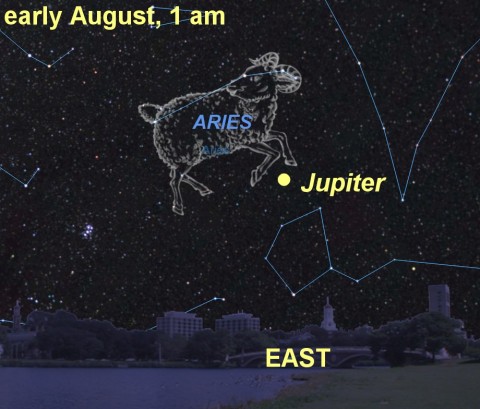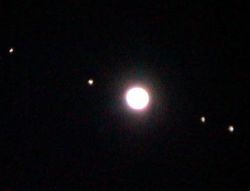
© Starry Night SoftwareCatch Jupiter rising in the east after midnight
Can't wait for NASA's
Juno probe to arrive at Jupiter in 2016? Then check out the gas giant shining bright in the overnight sky in August.
To find the largest planet in the solar system just look for a super-bright creamy colored star rising above the eastern horizon just after local midnight. As the night progresses Jupiter will continue to move ever higher and highlight the southern sky by the predawn hours. The fifth planet from the Sun is sitting within the boundaries of the zodiac constellation Aries, just underneath the front hooves of the celestial ram.
You can't miss Jupiter - even if you're stuck within a light polluted city - right now it's one of the most brilliant star-like objects in the entire sky. What makes it such a sparkler? First off, its a true monster in size - with a diameter measuring 142,000 km over 1300 Earth-sized worlds could easily fit inside it, making it a wide enough object in the sky to see as disk even when using the smallest of optical aids. Jupiter's also completely shrouded in highly reflective, light colored hydrogen and helium clouds, which just adds to its brilliance.
If you want to have a 'wow' moment and really get to know why Jupiter is a favourite with skywatchers then try training your binoculars on it. Hold them steady enough and you should be able to glimpse four of the planets largest moons first seen by
Galileo 400 years ago in 1609. Known as the
Galilean moons, they are Io, Europa, Ganymede and Callisto - all comparable in size to our own Moon and named after mythological figures. You'll find they look like tiny pinpricks of light beside the bright disk of Jupiter . You can get an idea of what you can see with this image I took (above) from my front steps of my suburban house. It kind of reminds me of a miniature solar system.

© Unknown
Your views get even better with a small telescope which can reveal the planet's signature cloud belts and even hints of the famous Great Red Spot - a hurricane the size of 3 Earths, raging for at least three centuries.
Check out my views of the planet and red spot.
So while we wait for Juno to make its 2 billion km, 5 year trek , it's amazing to think that Jupiter's so bright in our skies despite it being so far away that the reflected sunlight off its cloud-tops takes over 40 minutes to reach your eye!
Sky Extras: While your out gazing at Jupiter remember this Friday, August 5th also marks when asteroid Vesta reaches opposition, which means for skywatchers it's at is brightest it can get in our skies. Check out my
observer's guide posted last week.
Also
spaceweather.com is reporting that we should be on alert for possible auroras this weekend - especially for those in high and mid-latitude locations. A few days ago group of sunspots flung solar flares in the direction of Earth. So you if you have clear skies you may want to take a peak towards the northern sky around midnight the next few days.
Andrew Fazekas, aka The Night Sky Guy, is a science writer, broadcaster, and lecturer who loves to share his passion for the wonders of the universe through all media. He is a regular contributor to National Geographic News and is the national cosmic correspondent for Canada's Weather Network TV channel, space columnist for CBC Radio network, and a consultant for the Canadian Space Agency. As a member of the Royal Astronomical Society of Canada, Andrew has been observing the heavens from Montreal for over a quarter century and has never met a clear night sky he didn't like.
Reader Comments
to our Newsletter